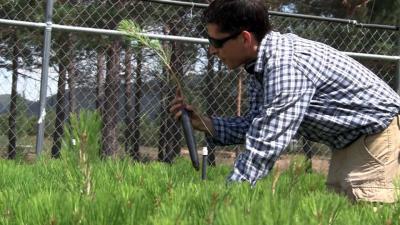NMSU forestry research center assist with restoration of wildfire damaged forests

Through the center's research in restoration ecology, forest genetics, tree improvement, forest biology and agroforestry, the forestry professionals in New Mexico have learned many things that will be crucial in restoring the 150,000 acres destroyed by the Las Conchas Fire in 2011, and the 297,845-plus acres consumed by the Whitewater-Baldy Fire, as well as the 44,330 acres affected by the Little Bear Fire this summer.
The work to replace the lost trees of the Las Conchos Fire has already begun. Small six-inch high seedlings now growing in the research center's nursery will be used in reclamation projects by the Santa Clara Pueblo.
"Last year, prior to the Las Conchas Fire, we were contacted by the Santa Clara Pueblo to grow seedlings for a riparian restoration and reforestation project," said Tammy Parsons, program coordinator and nursery manager at the Mora center. "This spring we delivered approximately 40,200 seedlings of 11 beaver habitat species, 11 bosque riparian species and Douglas-fir, as well as 650 cottonwood cuttings in tall pots."
The scope of the contract with the Santa Clara Pueblo changed when the Las Conchas Fire roared across reservation land.
"We have agreed to grow another 34,000 seedlings this year for the pueblo and there is the possibility of more in the coming years until they are able to start to recover from the fire," Parsons said.
Ohkay Owingeh Pueblo, which also suffered damage from the Las Conchas Fire, has contracted with NMSU for the center to grow approximately 18,000 Douglas-fir seedlings for planting this fall and next spring.
This is just one project in the center's conservation seedling program. The program is a cooperative effort with the New Mexico Energy, Minerals and Natural Resource Department forestry division that has provided the residents of New Mexico with high quality forestation stock at an economical price.
"Last year, we delivered 58,330 seedlings of 35 different species," Parsons said. "The forestry division has placed an order for 52,250 seedlings for this fall and next spring."
The seedlings production is the outcome of 40 years of research at the center.
Originally, the program focused mainly on the native and non-native conifer species associated with the Christmas tree and forest industries in the state. Through the outcomes of research and changing needs, this program now produces a much broader range of species from deciduous shrubs to coniferous trees.
"From the inception of this program in the late 1970s to the present, survival of seedlings planted on state and private lands in New Mexico has risen from 15 percent to over 80 percent," said John Mexal, interim technical advisor for the center and assistant department head of NMSU's plant and environmental sciences department.
"Numerous propagation and cultural protocols have been published through work in this program and through seedling production studies related to agroforestry, reforestation and restoration ecology research programs conducted at the center."
Knowledge gained in the center's forest genetic research and container nursery research programs have been applied to the agroforestry and reforestation research program. This program evaluates the performance of species, seed sources and stock types resulting from the other programs in conjunction with on-going site preparation and post-planting care research programs.
"Over the years, the program has helped determine optimum planting windows for reforestation, and worked with several mines in the state in developing revegetation technologies and programs," Mexal said.
Research has also focused on improving dry-land windbreak establishment in several agricultural regions in New Mexico. Windbreak parameters that have been studied include site preparation techniques such as v-ditch and weed barrier treatments, species and stock type and size.
The center has also researched the restoration ecology of disturbed riparian areas in the Sangre de Christo Mountains in northern New Mexico. The findings could also be used in the wildfire-damaged areas.
"The riparian restoration research has focused on developing stock types for riparian restoration in montane and foothill riparian sites," Mexal said.
In preventing future home and structural loss to wildfires, the center's work in urban and wildlife interfacing has become useful information.
"During the previous two decades, numerous vacation and permanent homes have been built within forested areas," Mexal said. "Landowners adopted and continued to adhere to a philosophy of hands-off approach regarding vegetation management of their properties."
"Simultaneously, these landowners have seen dramatic increase in wild land fire risks, reductions in wildlife populations and diversity, and finally reduction in overall forest health including increasing number of unhealthy trees and lack of forest floor vegetation."
In cooperation with the New Mexico Division of Forestry and the New Mexico Stewardship Program, Stewardship Incentives Program, the forestry research center has initiated research and demonstration residential sites in several areas in San Miguel County.
"The goals of the management treatments include protecting residences from wildfire, improving wildlife habitat and improving overall forest health on the property," said Mexal.
For access to more than 80 publications produced from the center's research, visit http://morasc.nmsu.edu/.


